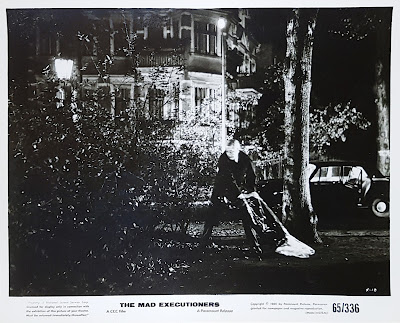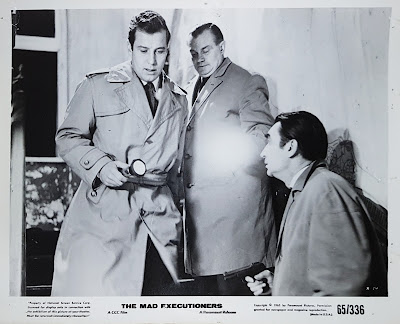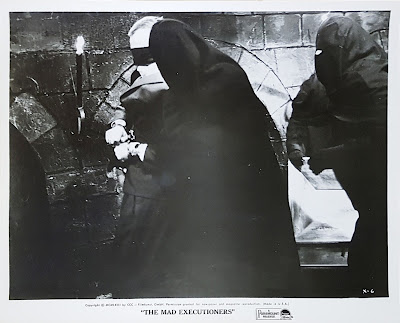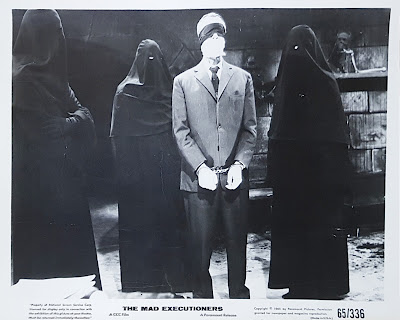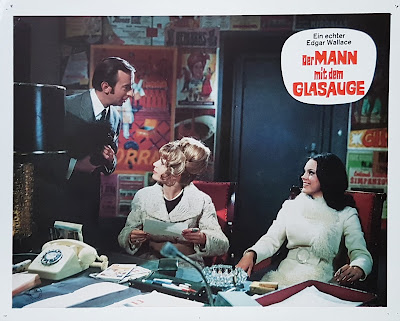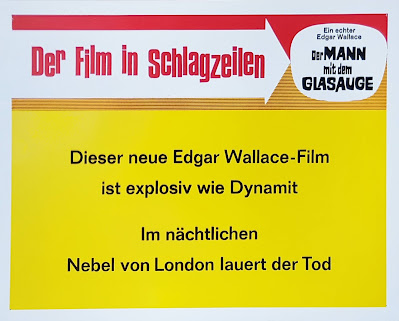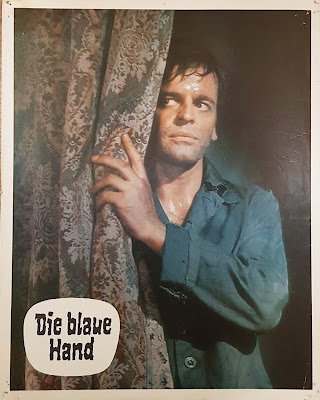Just received these eight US lobby cards for the Bryan Edgar Wallace film The Mad Executioners (1963).
A journey through Krimiland. Read all about the Teutonic fascination with Edgar Wallace, Bryan Edgar Wallace, Dr Mabuse, Jerry Cotton, Kommissar X, Father Brown or even Louis-Weinert Wilton and discover a world of hidden vaults, madmen in masks and bumbling butlers.
Thursday, December 16, 2021
Wednesday, December 1, 2021
New KOMMISSAR X boxset due out soon
Wednesday, November 24, 2021
Der Mann mit dem Glasauge/The Man With the Glass Eye (1968)
When an influential talent agent (Kurd Pieritz) celebrates signing on Leila (Heidrun Hankammer), a glamorous dancer, for a dance troupe by bedding her in a hotel, he gets killed by knife by a mysterious masked killer with a glass eye. This starts a series of violent killings and Scotland Yard being confronted with an international gang of drug and girl smugglers operating out of London’s seedy Soho.
The Man With the Glass Eye is one of those Wallace films that doesn’t even pretend to be based on any of his novels anymore. Its development, however, is probably way more interesting than a straight forward adaptation would have been as this is an example where a rival production from a different studio initially influenced by the success of the Rialto Wallaces in turn influenced a film in the original series back again.
Ladislas Fodor, an author who had been very influential in creating the 1960s series of Mabuse movies, had also provided a screenplay for Artur Brauner’s CCC Film production Das Phantom von Soho/The Phantom of Soho (1964), allegedly based on Bryan Edgar Wallace’s novel Murder by Proxy, a book that does not, however, seem to exist. In his screenplay Fodor focused on a string of knife murders in London’s red light district, committed by a masked killer in revenge for the actions of a gang of drug and girl smugglers.
Which kind of is the entire premise of The Man With the Glass Eye as well! (Right down to the exact nature of the reason for the revenge.)
For Rialto’s production Fodor supplied a treatment under the title “Die grausame Puppe” [The Cruel Doll]. His involvement went uncredited and his treatment was reworked by Paul Hengge whose name features in the credits of Rialto’s 28th Wallace movie.
There is speculation as to whether Phantom of Soho’s screenplay may have simply been sold over to Rialto at the time. Whatever exactly happened remains unknown but the similarities between both movies are striking (and possibly a subject for a future blog post).
The Man With the Glass Eye combines both the best and the worst of the latter day Rialto Edgar Wallace films.
Alfred Vohrer’s 14th and final Wallace production is often a feast for the eye with wonderful Bavaesque lightning being employed right from the start when we see the first hotel room murder filmed in eery red and blue hues.
Prior to that the mood was already set when the initial credits announced cast and crew members’ names in flashing lights on top of images of Piccadilly’s and Soho’s neon lights.
The film oozes a sense for the bizarre and the off kilter and whereas earlier Krimis clearly influenced Italy’s own burgeoning Giallo genre, those Gialli now in turn appear to exert their own influence back to the Rialto films (until they would ultimately begin to totally merge for their last couple of entries).
Glass eyes - let’s face it: not the most common of sights in real life - are everywhere: the killer wears one; they’re left behind on crime scenes: “Glasauge” is the name of a billiard club whose membership card is a glass eye and whose villainous owner (Narziss Sokatscheff) also wears one; they can also be seen in a variety of dolls in an eccentric curio shop (that also incidentally contains a cuckoo clock with the head of a small dragon popping out on the hour, an item that I now really need to have).
A ventriloquist with an outrageously designed doll featuring an oversized egg shaped head, gets seemingly killed by his own puppet by a man bizarrely dressed up in a life-sized costume even when on the run and in a shootout with the police.
Plenty of memorable characters even in smallest roles. Burly twins (or at least lookalikes) are e.g. engaged in a bar room brawl. A performer wears an Old Shatterhand outfit. And of course we also have an iconic killer wearing an impressive combination of mask, glass eye, black gloves, cape and hat, the kind of vision you just want to see stalk London’s foggy streets.
And of course there are gimmicks galore. Realistically most of those are highly unpractical but a lot of fun to observe regardless: radio senders stored in shoe heels; a hidden machine gun behind a wooden panel; entire databanks of Interpol and other police force members in a rotating filing cabinet in a billiard club that also contains enough surveillance equipment to make a Mabuse proud; elaborate remote control mechanisms at the home of a wannabe playboy including a seated glass compartment on train tracks for the convenience of visitors that is so painfully slow that it would be much faster to simply walk the few steps rather than make yourself comfortable in there.
Oh, and did I mention Peter Thomas being in top form yet again with a stellar musical score?
Despite all this, what does drag this film down considerably is an over abundance of silly humour.
True, the Rialto Wallaces always had some humoristic elements in them but even though one would be hard pressed to call them subtle, for this production the comedy is at its crassest and worst.
Stefan Behrens (in his one and only Wallace film and at the beginning of his career) plays Sgt. Pepper [sic!] as an irritatingly squeaky voiced comic relief. The character of Sgt. Pepper was carried over from the previous production, Der Gorilla von Soho/The Gorilla of Soho (aka The Gorilla Gang), where he was played in a straight fashion as a regular sidekick again next to Horst Tappert’s Insp. Perkins.
What Behrens is to Eddi Arent, Hubert von Meyerinck’s Sir Arthur is to Siegfried Schürenberg’s Sir John. Both actors took over the batons from comedic actors that left an indelible mark in the Rialto Wallace series and then cranked the format up to Level 11 where it became utterly unbearable.
This is von Meyerinck’s third performance as Sir Arthur (and his 5th and final one in the series overall) and he is as loud and unpleasantly pervy as expected from him. He is both a bombastic and ignorant caricature of a Prussian General as well as a grotesque poster child for harassing bosses everywhere. His constant (but very willing!) object of attraction is Ilse Pagé (also in her 5th and final appearance in that series) as his secretary Mabel. Pagé’s Mabel was always ditzy but during the course of her films morphed into the most obnoxious stereotype of the Dumb Female.
And if those characters alone weren’t enough: The film is chockfull of the lowest kind of gutter humour with added over-the-top effeminate camp gay displays. At one stage a barkeep explains to Sir Arthur how to create a cocktail by telling him to “blow hard, else it won’t get stiff”. That kind of line makes the Carry On series look like the epitome of sophistication.
There is exactly one scene where the humour works and that ironically is one that may have gone right over the heads of a lot of the original German audience at the time: When the girls get locked into the back of a van, a sign on it in English states that it contains “fresh meat”.
Another drawback is that there is not a single character, male or female, who could genuinely serve as a protagonist or even hero or heroine that the audience could root for. The closest The Man with the Glass Eye comes in this regard is Horst Tappert’s Scotland Yard inspector who is ultimately, however, way too charmless and dull to genuinely engage with.
Then again, it seems that the German audience does enjoy charmless and dull when it comes to their fictional detectives as just a few years later Tappert started to feature in Derrick, a TV crime series that ran over 25 seasons from 1974-1998. Derrick also sold well abroad (in places such as Italy, the Netherlands and Scandinavia). His portrayal was not too far removed from his Inspector Perkins and it also featured Fritz Wepper as his assistant Harry Klein.
The two actors first met on The Man with the Glass Eye where Wepper plays Bruce Sharringham, a drug addicted member of an aristocratic family, in love with Karin Hübner’s dancing girl Yvonne Duval much to the dismay of his wonderfully snobbish and domineering mother (Friedel Schuster).
A lot is packed into the plot of this film, probably too much for its own good, so in the end it is often drowned in a plethora of different plot points without giving the right amount of focus to all those varied strands. The doomed love affair between those two characters e.g. for the longest time often feels totally out of place and just fizzles out among all the other plot strands and yet it is only towards the end that its true implications are revealed and one wishes it had been built up much stronger.
[WARNING: SPOILERS AHEAD - SKIP UNTIL THE END OF SPOILERS NOTICE IF NEEDED]
The Man With the Glass Eye has a tragic ending that similarly to Room 13 managed to pull at the heart strings in a way that very few others in the series with more conventional endings ever managed to succeed in doing.
Karin Hübner’s Yvonne is revealed as being a girl who had previously been abducted and forced into prostitution. She now seeks revenge on her former tormentors, most of all her lover’s mother who had been acting as the true eminence grise behind the gang and ends up killing Yvonne shortly before Scotland Yard and her fiancé can come to the rescue, leaving Fritz Wepper’s character both in mourning over the death of his true love and the betrayal of the mother he had always worshipped.
Rather than being a regular Wallace super villain, Yvonne had been a benevolent vigilante who saved hundreds of girls from the kind of fate that she had had to endure herself.
[END OF SPOILERS]
Apart from this love affair we have the knife killings of the glass eyed killer, a separate string of killings amongst the dance crew, a gang of girl smuggling white slave traders and drug deals taking place with the help of specially prepared billiard queues.
All of those do somewhat come together at the finale which, however, does not prevent a feeling of at times being overburdened by way too many diverse elements that don’t all join together as a consistent unity.
The fact that Rialto is clearly a representative of “Grandfather’s cinema” despite attempting to go with the times in their depiction of nudity, violence and drug use is very obvious when we see that every single one of the heroin users in this film just greedily gulps it down. Just a few short years away from the scenes depicted in Christiane F. here are film makers that don’t seem to comprehend the idea that the vast majority of heroin users would either inject, smoke or sniff and snort it but never really eat it.
Some choreographed dance scenes in this production were lifted from the film Scala - Total Verrückt (1958, translates as: "Scala - Totally Crazy"), a CCC variety show comedy directed by and featuring Eric Ode who late become one of Germany’s most popular TV detectives in Der Kommissar.
All in all The Man With the Glass Eye is a stunning looking swan song for Alfred Vohrer’s time with Rialto. Containing a Giallo flair, this is quite bloody at times with occasional glimpses of nudity and a wonderfully tragic ending that is only marred by an overabundance of cheap humour and a confusion of too many divergent plot elements.
AVAILABILITY
The Man With the Glass Eye is available as an English friendly standalone DVD with English subtitles and dubs but also featured in the final set (Edition 8) of the Edgar Wallace Edition together with the last four films of the series and of course also in the complete Rialto Wallace DVD Edition.
These are PAL Region 2 releases and can best be ordered via Amazon DE. Usually if bought from outside the EU ordering from there may be subject to customs charges but they may also show up as import discs on Amazon UK or Amazon US.
The film is also available in the same English friendly format on a German Blu Ray. Whereas the DVD Box releases were chronological for the Blu Ray box sets the films were published in a more random order and this movie appears on Blu-Ray Edition 9 with two other films. Just like on DVD there is also a boxset with the complete Rialto Wallace Blu Rays.
For anyone splashing out on the complete sets (either on DVD or Blu Ray): Only about two thirds of those are English friendly.
Thursday, October 14, 2021
German Lobby Card Set for DER MANN MIT DEM GLASAUGE/THE MAN WITH THE GLASS EYE (1968)
I also brought home this set of lobby cards for Der Mann mit dem Glausauge/The Man With the Glass Eye (1968) from my recent trip back to Germany.
This Krimi is the 14th and last of the Rialto Edgar Wallace productions directed by Alfred Vohrer,
Looking at those photos I am reminded that I had only ever seen this movie once and can't remember much of it.
Looks to me it is now time for a rewatch...
Monday, October 4, 2021
German Lobby Card Set for DIE BLAUE HAND/CREATURE WITH THE BLUE HAND (1967)
Just got back from a trip to visit my family in Germany and amongst the stuff I brought back was this German set of lobby cards for Die blaue Hand/Creature with the Blue Hand (1967).
It's definitely not in the best of conditions - in actual fact the scans make them look better than they truly are! - but can't say I care too much. They were fairly cheap and I am just happy I have those, besides with those historical documents I often like a certain layer of patina. Based on some scribblings at the back (and even a postal stamp!) those seem to have been used in Italy where the film was released under the title L'artiglio blu.
Thursday, August 26, 2021
Die blaue Hand/Creature with the Blue Hand (1967)
Creature with the Blue Hand/Die blaue Hand (1967), directed by Alfred Vohrer, is one of the few exceptions.
And we don’t just get Kinski once but (at least for a short period) twice as he plays a pair of twins, Dave and Richard Emerson.
Dave is being convicted for the murder of a gardener at his family’s estate, considered insane and subsequently incarcerated in a mental institution. In order to convince the judge that he is totally compos mentis, Dave jumps towards the bench and does a spewing and foaming Kinski, declaring his innocence.
And strangely enough for a production that for a large part deals with all matters of insanity, this is pretty much the only time we see the actor letting loose. For large parts, Kinski here gives a very subdued but nevertheless mesmerising performance.
One night Dave manages to escape from the asylum with the help of a mysterious stranger and he legs it to his family castle, conveniently located just a short distance away from the institution. Alas, while on the run a nurse and a warden get killed and suspicion falls yet again on Dave.
After arriving at the castle his brother Richard happens to vanish and Dave decides to slip into his twin brother’s clothes and impersonate him, a ruse that only the resident Scotland Yard detective (Harald Leipnitz, also in Der unheimliche Mönch/The Sinister Monk and Die Gruft mit dem Rätselschloß/The Curse of the Hidden Vault) sees through fast and yet despite dealing with a convicted killer, suspected of two further murders and officially declared insane, he and his boss Sir John (Siegfried Schürenberg) allow Dave to continue the charade in order to help with the investigation and flush out the real killer.Creature with the Blue Hand is one of those productions that, if you were brave enough to attempt an in depth plot analysis, would lead to an utterly byzantine labyrinth of incomprehensible madness.
Nothing and no-one is as they seem. Twists are thrown at the audience in regular intervals. And everybody seems to have secrets, dual personas and hidden agendas abound.
Yet, it’s such a well executed, good looking, fast moving and most of all fun piece of 1960s Krimi exploitation that few people would ever dare question the logic behind the plot. (And those that do, just need to chill.)
Though nominally based on Edgar Wallace novel The Blue Hand (1925), the film contains practically nothing from its source and instead features a completely new plot. Rialto had previously already commissioned two vastly different scripts also very loosely based on the novel. For the film version a third script by Herbert Reinecker (aka Alex Berg in the credits) was finally used.
In the novel (and somewhat similarly in the previous two scripts) the “blue hand” refers to blue hand prints left behind as mysterious symbols. In the film, however, the blue hand is now the murder tool. The killer is a hooded henchman who kills with the aid of switch blades hidden in a blue gauntlet taken from a knight’s armour belonging to a legendary French ancestor of the Emerson family.
Though mansions and castles often feature prominently in the Edgar Wallace films, they are usually placed in urban areas (courtesy of stock footage of London). Creature with the Blue Hand is devoid of that and for the most part plays in two locations: the spooky castle of the Emersons and Dr Mangrove’s mental institution.
As a result of that there is an even stronger focus on Gothic tinged horror in a modern setting than normal at the expense of the familiar crime thriller aspect.
The castle set allows Vohrer to go all out with Bavaesque colour schemes and his trademark unusual angles (e.g. faces filmed and distorted when shot through a wine glass).
As can be expected in a Wallace film, there seem to be more secret doors and alleys in that residence than regular walk ways. And let’s not forget the bizarre assortment of creaking knight’s armours, skeletons, cobwebs and… mannequins hanging from nooses or seemingly knifed by Dave as an indicator of his madness. (Of course given that the entire film’s premise is all about exonerating Dave, one wonders why a sane Dave would have spent his time staging tableaus of murders and suicides for kicks.)
The ultimate pièce de résistance, however, is Dr Mangrove’s asylum straight out of bedlam.
Is it exploitative? In questionable taste? No longer acceptable for modern-day attitudes toward mental illness?
Yes, yes and yes again.
But it is also a hell of a lot of fun to watch and, pardon the pun, utterly insane.
Dr Mangrove is played by Carl Lange (also in Der Frosch mit der Maske/Fellowship of the Frog and Der Hexer/The Ringer) and the monocle he is wearing would have deserved a separate credit.
The inmates run the whole gamut of stereotypes par for films of that nature and also include a professional stripper with a compulsion to take her clothes off nonstop, much to the delight of Siegfried Schürenberg’s pervy, grand-fatherly Sir John who in his introductory scene in Scotland Yard raves against contemporary youth culture until his young female and mini-skirt wearing assistant (Ilse Pagé, soon to be a series regular in the very same role) drops in, causing him to be all charming and overly attentive again.
On top of this curious assortment of characters, the asylum also features locked rooms straight out of I’m A Celebrity, Get Me Out of Here into which rats and snakes are dropped through hidden doors in front of a terrified inmate.
Despite having the privilege of Kinski in the lead, the film is actually not dominated by him. In actual fact, he is absent for larger parts of it when the focus is on anyone of a dozen characters crucial to the story.
The humour is toned down significantly in comparison to earlier entries and mainly comes courtesy of Sir John. Martin Böttcher reliably as ever provides the swinging film score. And Albert Bessler’s butler breaks down the 4th wall in the final scene when he announces that the next Wallace production would be Der Mönch mit der Peitsche/The College Girl Murders.
This film was Diana Körner’s film debut. She plays Dave’s sister who during the course of the production gets incarcerated against her will by Dr Mangrove with the attempt to drive her mad. Körner over the years would become a very popular TV actress and is still active today in her mid-70s.
Also worthy of note is the pretentiously named “Le Petit Maxim”, a deserted rural nightclub that appears to have been filmed on a farm.
All in all, Creature with the Blue Hand is one of the best examples of the second half of the Rialto series. Fast moving action, combined with creepy Gothic horror and an assortment of eccentric characters result in a memorable production.
Quentin Tarantino has referenced Creature with the Blue Hand as one of his favourite movies. A strong vote in favour that is only softened by the fact that he also appears to lay an identical claim for seemingly another 10.000 other flicks as well.
There also appears to be a US version of the movie released in 1987 under the title The Bloody Dead by Sam Sherman containing newly filmed inserted gore scenes.


